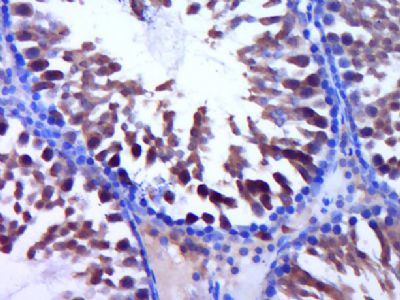WNK1 controls sodium and chloride ion transport by inhibiting the activity of WNK4, potentially by either phosphorylating the kinase or via an interaction between WNK4 and the autoinhibitory domain of WNK1. WNK4 regulates the activity of the thiazide sensitive Na/Cl cotransporter, SLC12A3, by phosphorylation. WNK1 may also play a role in actin cytoskeletal reorganization.
Function:
Serine/threonine kinase which plays an important role in the regulation of electrolyte homeostasis, cell signaling, survival, and proliferation. Acts as an activator and inhibitor of sodium-coupled chloride cotransporters and potassium-coupled chloride cotransporters respectively. Activates SCNN1A, SCNN1B, SCNN1D and SGK1. Controls sodium and chloride ion transport by inhibiting the activity of WNK4, by either phosphorylating the kinase or via an interaction between WNK4 and the autoinhibitory domain of WNK1. WNK4 regulates the activity of the thiazide-sensitive Na-Cl cotransporter, SLC12A3, by phosphorylation. WNK1 may also play a role in actin cytoskeletal reorganization. Phosphorylates NEDD4L (By similarity).
Subunit:
Interacts with SYT2 (By similarity). Interacts with WNK3 and WNK4 (By similarity).
Subcellular Location:
Cytoplasm.
Tissue Specificity:
Widely expressed, with highest levels observed in the testis, heart, kidney and skeletal muscle. Isoform 3 is kidney-specific.
Post-translational modifications:
O-glycosylated.
Phosphorylated upon DNA damage, probably by ATM or ATR.
DISEASE:
Defects in WNK1 are a cause of pseudohypoaldosteronism type 2C (PHA2C) [MIM:614492]. An autosomal dominant disease characterized by severe hypertension, hyperkalemia, hyperchloremia, mild hyperchloremic metabolic acidosis in some cases, and correction of physiologic abnormalities by thiazide diuretics.
Defects in WNK1 are a cause of hereditary sensory and autonomic neuropathy type 2A (HSAN2A) [MIM:201300]. A form of hereditary sensory and autonomic neuropathy, a genetically and clinically heterogeneous group of disorders characterized by degeneration of dorsal root and autonomic ganglion cells, and by sensory and/or autonomic abnormalities. HSAN2A is an autosomal recessive disorder characterized by impairment of pain, temperature and touch sensation, onset of symptoms in infancy or early childhood, occurrence of distal extremity pathologies (paronychia, whitlows, ulcers, and Charcot joints), frequent amputations, sensory loss that affects all modalities of sensation (lower and upper limbs and perhaps the trunk as well), absence or diminution of tendon reflexes (usually in all limbs), minimal autonomic dysfunction, absence of sensory nerve action potentials, and virtual absence of myelinated fibers with decreased numbers of unmyelinated fibers in sural nerves.
Similarity:
Belongs to the protein kinase superfamily. Ser/Thr protein kinase family. WNK subfamily.
Contains 1 protein kinase domain.
SWISS:
Q9H4A3
Gene ID:
65125
Database links:
Entrez Gene: 65125 Human
Entrez Gene: 100503989 Mouse
Entrez Gene: 232341 Mouse
Entrez Gene: 116477 Rat
Omim: 605232 Human
SwissProt: Q9H4A3 Human
SwissProt: P83741 Mouse
SwissProt: Q9JIH7 Rat
Unigene: 726723 Human
Unigene: 728846 Human
Unigene: 333349 Mouse
Unigene: 484782 Mouse
Unigene: 27409 Rat
Defects in WNK1 are a cause of pseudohypoaldosteronism type II (PHAII), an autosomal dominant disease characterized by severe hypertension, hyperkalemia, and sensitivity to thiazide diuretics which may result from a chloride shunt in the renal distal nephron.
| Picture |
Paraformaldehyde-fixed, paraffin embedded (Rat testis); Antigen retrieval by boiling in sodium citrate buffer (pH6.0) for 15min; Block endogenous peroxidase by 3% hydrogen peroxide for 20 minutes; Blocking buffer (normal goat serum) at 37°C for 30min; Antibody incubation with (WNK1) Polyclonal Antibody, Unconjugated (SL724R) at 1:400 overnight at 4°C, followed by operating according to SP Kit(Rabbit) (sp-0023) instructions and DAB staining.
|
|
|
